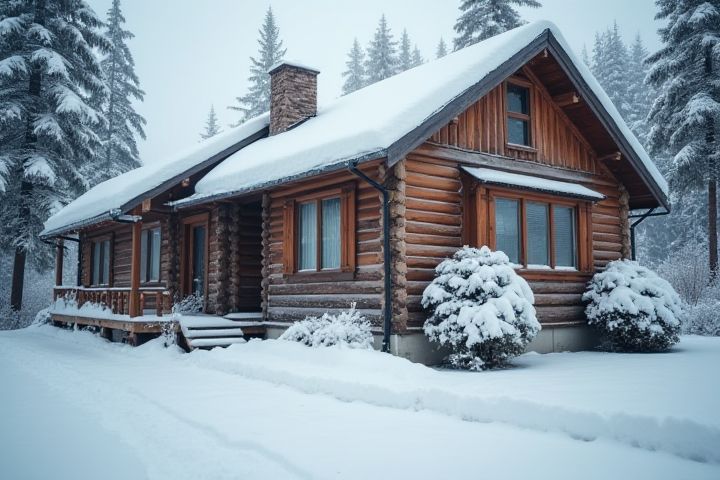
To effectively winterize your house, start by sealing windows and doors with weather stripping or caulk to prevent drafts. Insulate exposed pipes, especially in unheated areas, to avoid freezing and bursting during harsh temperatures. Check the heating system, replacing filters and scheduling maintenance to ensure optimal performance throughout the winter months. It's also crucial to drain outdoor faucets and sprinklers to prevent water damage. Lastly, consider adding insulation to your attic or crawl space to enhance energy efficiency and keep your home warm.
What Is Needed To Winterize A House
Insulate doors and windows
To effectively winterize your house, focus on insulating doors and windows to prevent heat loss. Using weatherstripping on gaps can reduce drafts by up to 80%, offering significant energy savings. Consider installing insulated curtains, which can maintain indoor temperatures while blocking cold air and reducing heating costs by as much as 25%. Additionally, applying window film can enhance insulation, reflecting indoor heat back into your home and further increasing efficiency.
Check and clean gutters
To effectively winterize your house, start by checking and cleaning your gutters to ensure optimal water flow and prevent ice damming. Clogged gutters can lead to overflowing, causing potential damage to your roof, siding, and foundation. Use a sturdy ladder and wear gloves to remove leaves, twigs, and debris, then flush the gutters with water to confirm proper drainage. By maintaining clean gutters, you protect your home from winter moisture issues and promote a healthier, more resilient property throughout the colder months.
Inspect roof for leaks and damage
Inspecting your roof for leaks and damage is crucial for effective winterization. Look for missing or damaged shingles, as well as signs of wear around vents and chimneys, which can lead to water intrusion. A winter storm can bring heavy snow, so ensure your roof can support additional weight by checking for sagging or structural issues. Addressing these concerns before winter sets in can save you from costly repairs and ensure your home remains dry and safe throughout the season.
Service heating systems
To winterize your house effectively, prioritize servicing your heating systems to ensure optimal performance. Schedule a professional inspection of your furnace or boiler, checking for any necessary repairs or adjustments to enhance efficiency and safety. Replace older or dirty filters every 1-3 months to maintain air quality and system effectiveness, promoting a consistent temperature throughout your home. Additionally, consider adding insulation to ducts and pipes for improved energy retention, potentially saving you up to 30% on heating bills.
Seal cracks and openings
Sealing cracks and openings is crucial for effective winterization, as it can reduce heating costs by up to 30%. You should inspect areas such as windows, doors, and the foundation for any gaps that allow cold air to enter. Use high-quality caulk for smaller cracks and thermal insulation for larger gaps, ensuring a tight seal to maintain your home's warmth. Taking these steps not only enhances comfort but also prevents moisture intrusion, which can lead to costly repairs.
Drain outdoor faucets and sprinkler systems
To winterize your house effectively, begin by draining outdoor faucets to prevent freezing and potential pipe damage; simply turn off the water supply and open the faucet until no water remains. Next, ensure you blow out the sprinkler system, removing any trapped water to avoid freeze-related complications, which can occur at temperatures below 32degF. Consider using an air compressor for an efficient blowout process, setting the pressure between 30-50 PSI to avoid damage. Finally, insulate exposed pipes and outdoor spigots with foam covers or insulating tape to provide added protection against the cold.
Install storm windows or plastic window insulation
Installing storm windows can enhance your home's energy efficiency by adding an additional layer of insulation, thereby reducing heat loss by as much as 25 to 50%. For a cost-effective alternative, applying plastic window insulation kits can create an airtight seal, potentially saving you 14% to 17% on heating costs. Ensure that you measure your windows accurately before purchasing materials, as improper fit can compromise insulation effectiveness. You may also consider using weather stripping around doors and windows to further minimize drafts and enhance your winterization efforts.
Clean and inspect chimneys and fireplaces
Cleaning and inspecting chimneys and fireplaces is crucial for winterizing your home to ensure safety and efficiency. Schedule a professional chimney sweep to remove soot, creosote, and blockages, reducing the risk of chimney fires by up to 80%. Inspect the chimney structure for cracks or deterioration, which can lead to dangerous carbon monoxide leaks, and ensure that the flue damper opens and closes smoothly. By prioritizing this essential step, you can enhance the performance of your heating system while providing a warm and secure environment throughout the winter months.
Check and maintain attic insulation
Attic insulation is crucial for energy efficiency and temperature regulation during winter months; you should aim for an insulation R-value of at least 38 in colder climates. Inspect your attic for any gaps or damage, as just 10% of insulation loss can cause a significant increase in heating costs. You may need to add or replace insulation materials, such as fiberglass batts or spray foam, to ensure complete coverage. Proper ventilation in the attic also prevents moisture buildup, which can compromise insulation effectiveness and lead to mold issues, so consider installing roof vents if needed.
Reverse ceiling fan direction for heat retention
To effectively winterize your house and enhance heat retention, adjusting the direction of your ceiling fan is essential. Set the fan to rotate clockwise at a low speed, which creates an updraft that pushes warm air trapped near the ceiling back down into the living space. This simple adjustment can increase energy efficiency, potentially reducing heating costs by up to 15%. Keeping your ceiling fan in this direction during the colder months ensures that your home remains cozy while minimizing energy consumption.
